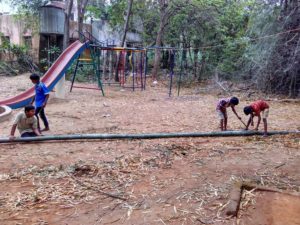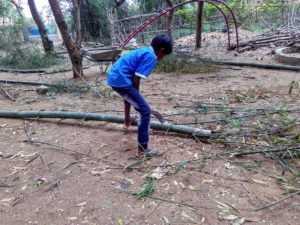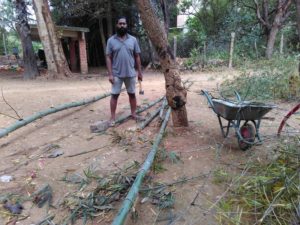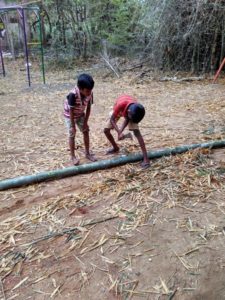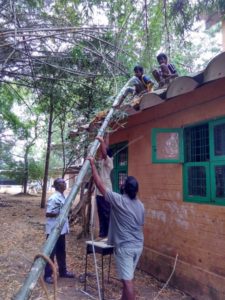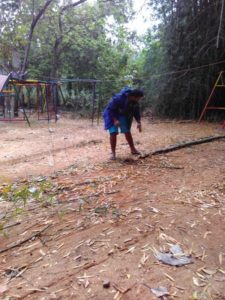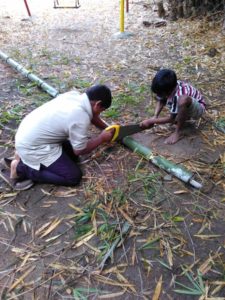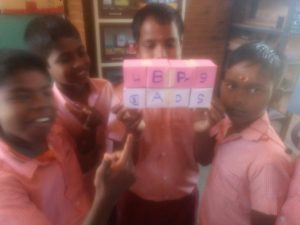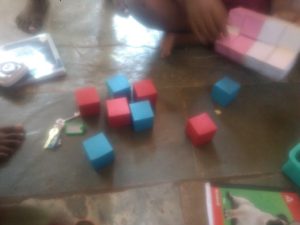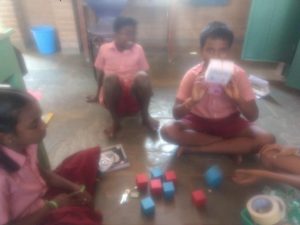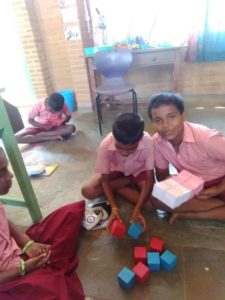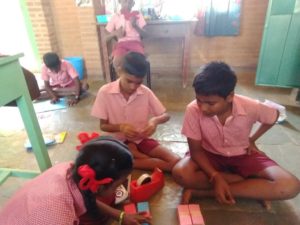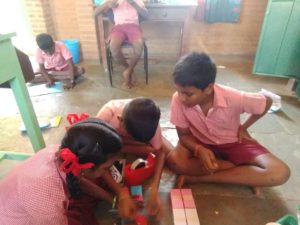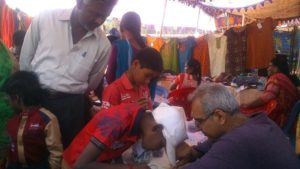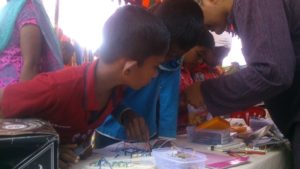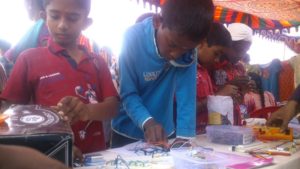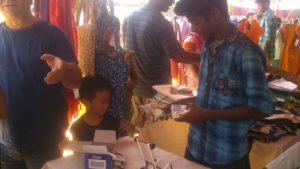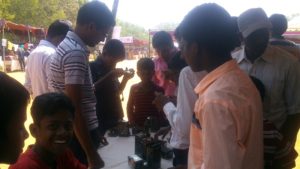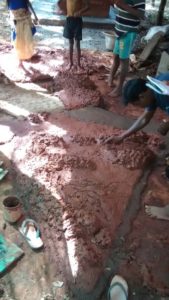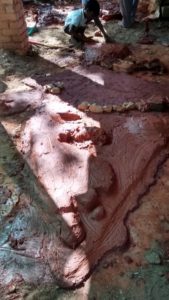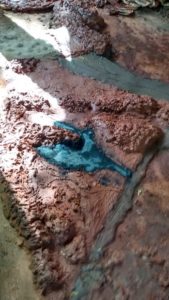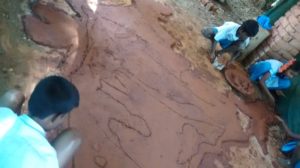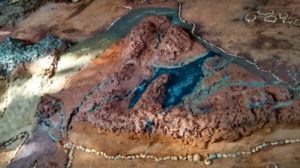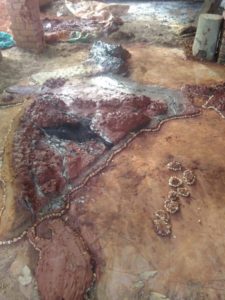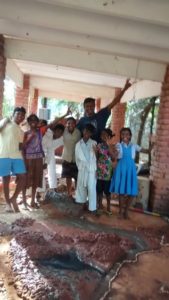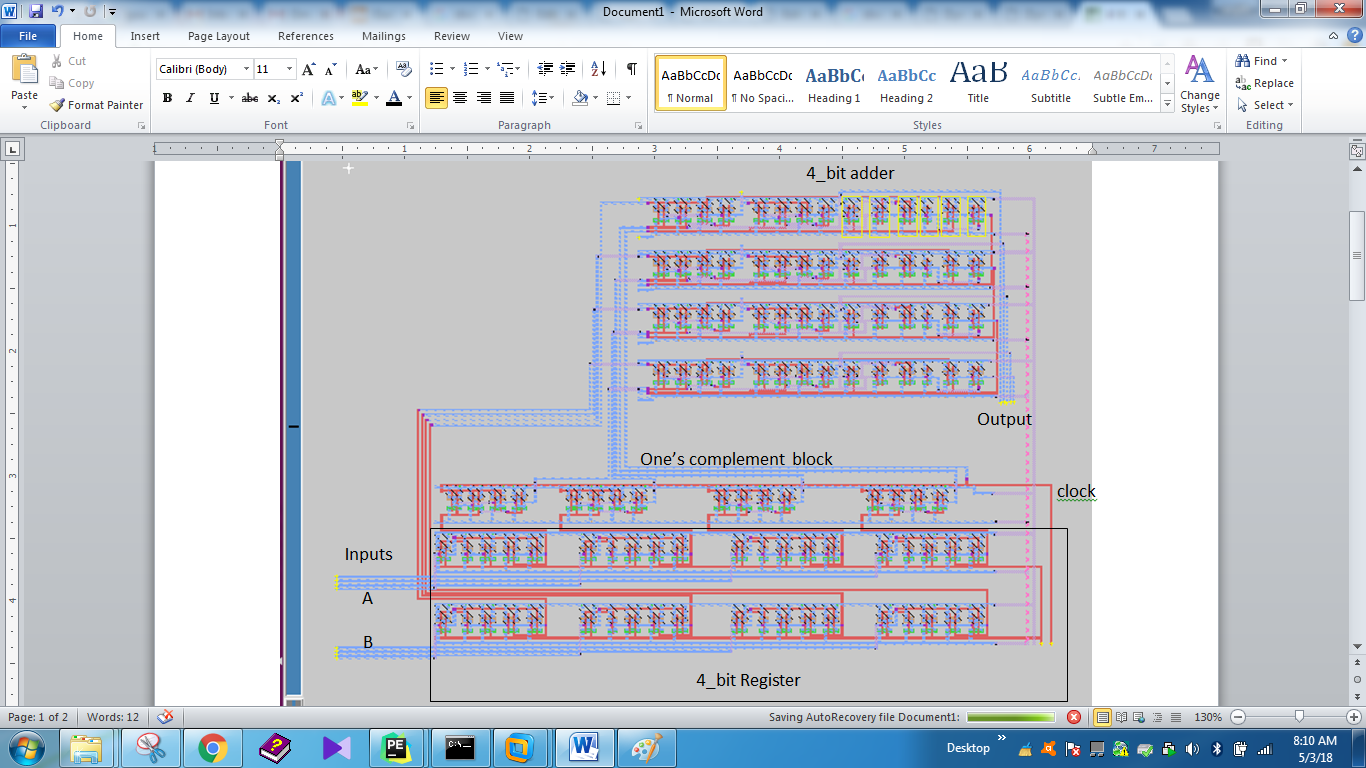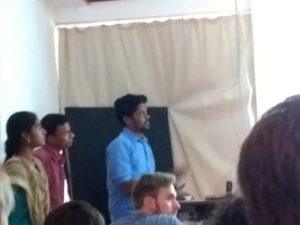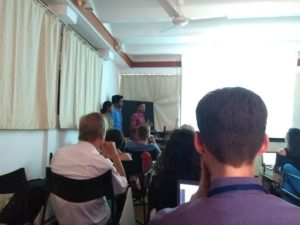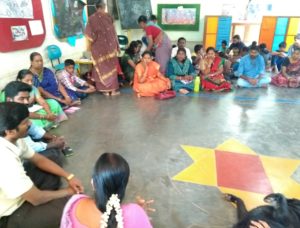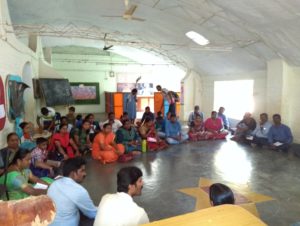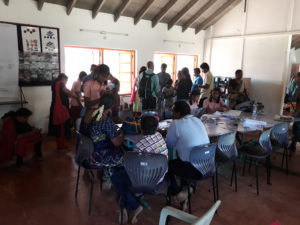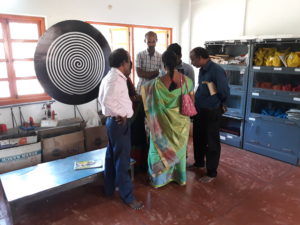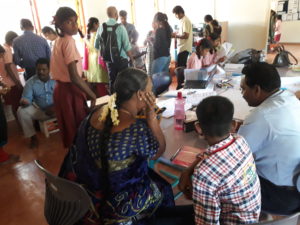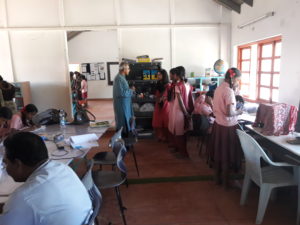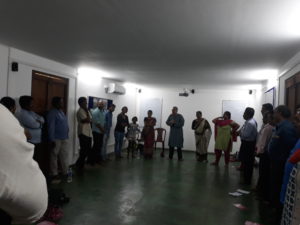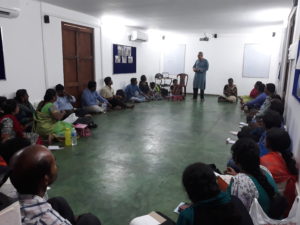In Saturday school students had different tasks to do in school. One of them was cutting bamboo tree and making them into pieces for putting banner in many places in Auroville. The banner was for Isai ambalam School. The day before (Friday) students had already cut some of the bamboo tree. We knew the specifications of how many bamboo sticks are needed and what are all the measurements. We need to 12 sticks of 17 feet (5 meters and 10 cm) and 12 sticks of 11 feet (3 meters and 35 cm). Students measured the length using tape and cut them using axe ,saw and knifes. While doing this task the students measurements and conversion of feet to meters.
Steps for perfection
Saranya
Everyone wants to be a perfection on their work. We worked through material provided by Aparajita Foundation (that we plan to use with children) and arrived at the following steps that I found useful:
- Clarity of what we are doing.
- Collect resource materials, organize and execute.
- Keen observation and attention to details.
- Be conscious.
- Time frame.
- Check for completion and correction whatever and whenever necessary.
- Clean up.
- Trust my work but correct if necessary.
One of the volunteers Sahana put the workshop together with the other teachers at Isai Ambalam School.
Scratch and Geogebra course in Savarirayalu school
-Poovizhi and Ranjith
Savarirayalu nayakar govt girls high school is applying for a national award in ICT and asked our support on Scratch and Geogebra. Children from 8th and 9th grade were interested to learn. On the first day we did a scratch course. We gave them a task to ask multiple questions and if the answer is correct it’ll move on to the next question else it’ll ask the same question until it is correct. Children were able to use controls and were able to find the logic. The next two days we did a course on Geogebra. Children first explored all the tools available in Geogebra and then drew an equilateral triangle. Some of the children drew it using regular polygon. Then we asked them to draw equilateral triangle by finding the intersection point. They used two circles and found the intersection point and were able to draw the triangle. Then we asked them to draw different triangles and find the sum of the angles of all the triangle. They found that the sum of all three angles of a triangle is 180 degree for all triangle.
On second day, we asked them to draw circle and to find out ratio of circumference and diameter of different circle.They found that the ratio of circumference and diameter is 3.14 (Pi value) for all circle. Then, we asked them to draw chord line on circles and make a triangle by choosing a point on circles with chord as a base of triangle and measure the angles of triangles. Then we asked them to find out the pattern in triangles in different circle. They found that the angle for all triangle at third vertex point on one section of circle is same and different from angle on other section of circle which are separated by chord line on circle and also the sum of angles of both section of circle is always 180 degree for all circle with different chord length.
Introduction to Analog Layout
saranya
There are many things mater in analog passes for success (I.e noise,bandwidth,amplitude and frequency). I learnt few difference between analog layout and digital layout. Compare to digital layout it occupies less space and looks neat. We started doing step by step orthogonality, fourier series, exponential & expansion as sequence, laplace transform. First we did theoretical part that is Rc (Resistor and Capacitor) circuit with the input of sine wave and unit step function. By using exponential and laplace transform we found the output of unit step and sine wave in RC circuit. Now I have started calculating sheet resistance of each component (poly,metal,contact,etc..) that we will use it in magic tool.
Building an Infinity cube with the 6th graders.
Along with the 6th graders from Udavi school, the children wanted to build something to show to their parents. Initially a few weeks back we had build cubes from chart paper. Then I remembered once Ravi A who had come to Isaiambalam to show his work, had introduced some kirigami and one thing that really got me amazed was an infinity cube he had built. This idea struck me and we along with the children decided to convert their cubes to an infinity cube.
So began the taping cutting gluing job:
Sangamam in Auroville
-Poovizhi
Auroville celebrated Sangamam where all the workers and their families from the bioregion came together and enjoyed the events. It was a whole day of sports, arts and crafts, cultural programs and many more events. We were allocated a stall for STEM land. Three children from Isai ambalam and 4 children from Udavi came and they setup the stall.
We asked people to display their name or their first letter using the seven segment displays. Children also were playing games like abalone, Pylos, Dobble and gave some challenging activities to the people.Children asked them to solve the rubiks cube and cast puzzles. Children and the adults were happy to these activities. They were able to display their names using the seven segment displays. Some of them were also able to solve the cast puzzles and were proud of solving them.
We also gave a talk about STEM land under unending education. Bala talked about STEM land in Isai Ambalam and the EBD’s we do there. He also connected with his personal life and the education system that he had before and said that he’s happy to see children having an alternative educations. He also added that we can support more children in Isai ambalam school and people who are interested to join their kids can visit Isai ambalam. I talked about STEM land in Udavi and how children take responsibility of their learning. We also said that we offer free courses related to engineering and people who are interested in learning are always welcome to STEM land.
Nilavazhagan who has completed B.Tech visited our stall in Sangamam and was interested in learning more on what we do. Yesterday he came to STEM land and visited. He wanted to continue and started to come from today onwards and was learning things with children.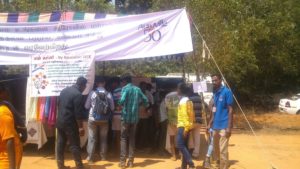
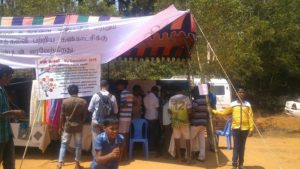
India map
Students from 6th and 7th graders made India map using red soil, clay, bricks, pebbles, sand, alluvial soil, black soil. They first wanted to make it on the loft. First they drew a three meters height and three meters width box. Each student were given separate parts of the country to draw. By using graph sheets they drew the map of India.
They made the structure of India using clay. Since there was heavy sun on the loft, the clay got cracks. So students decided to make in on the ground. They did the same thing in the ground. Now they gave shelter to it. But still after a few days it had cracks. Then students came up with a solution that since the layer of the clay is so thin, it had cracks. We had some remaining soil left after the work of oven Education By Design (EBD), so students used that red soil and created another layer above the clay. By using bricks and red soil students built the mountains. In order to differentiate between desert, mountains and rivers they used different materials. For the rivers they mixed the cement with water and built many rivers in India. For desert, they put normal sand. In the eastern parts of the country, they put the alluvial soil. Because the rivers take the alluvial soil and leave it in the delta before joining the sea. Tasks were properly divided among students and it took about two weeks for them to complete the map. The final output of the map was looking good with mountains, rivers and other geographical features. By doing this EBD they learnt Geography of India. Their teacher Ragu supported them.
designing 4-bit microprocessor using magic tool
I started designing 4-bit microprocessor in magic tool, it consists of three block:
- 4-bit full adder
- register to store an input data.
- 4-xor gates and one carrier input is used to 2’s complement for subtraction
Inputs which are used in it :
- two 4-bit data A and B
- carrier input
- clock
In this microprocessor, the adding operation is takes place when carrier input is 0, and the subtraction operation takes place when carrier input is 1. During subtraction, one’s complement block takes one’s complement B data and it send to 4_bit adder. The carrier input value is 1 at subtraction. so it’s form two’s complement of B data in 4-bit full adder.
And also sanjeev taugth me, to align block in order to reduce area and to create data bus with multiplexing two inputs.
STEM land presentation at The Bridge
We presented our paper about STEM land in Udavi and Isai ambalam in The Bridge a collaborative research in Auroville. Our paper was under unending education on 25th Feb 2018. We started the presentation with the core values of STEM land and about the activities and interventions in STEM land. And continued with the plans and tracking method that we follow in STEM land. Then we shared about the Leadership in action program that we do with children and few examples of how it had benefited them to be responsible.
Then we shared about the learning environment in STEM land where there is no hierarchy and learning becomes a social activity and spreads without one to one inputs from facilitators. We also pointed out how STEM is moving towards STEAM and the outcome of children after coming to STEM land. Then we shared about STEM land in Isaiambalam. 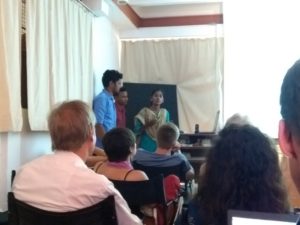
We explained about the real life challenges that children take up and how they solve it through EBD. People enjoyed the session and happy to see children work. We showed them few pictures of children working on their EBD and the designs they have build like, Pond, honey bee, Bamboo torch, garden and kitchen waste water management. People enjoyed the presentation and were interested to know more about STEM land.
Azim Premji and teachers from Government school
Around 37 government school teachers and a team from Azim Premji unversity visited STEM land. We presented a paper on “STEM land in Isaiambalam school” at Sindhanai Sangamam symposium. Some of them were inspired from our talk and they came to visit STEM land. The teachers saw what the children were working on in Isai Ambalam school. We had a Saturday school and all the children were working on the EBDs. The teachers interacted with us as well as with the children. One of the teachers reflected that we were thinking of each child and addressing his or her need differently and that was something she wanted to do in her classroom.
After that they visited STEM land in Udavi school. Children showed them few projects. The teachers also tried to solve caste puzzles. We also conducted a Stewardship session for the them lead by Sanjeev.
At Isai Ambalam School


